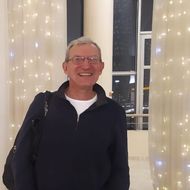Physicists from Russia and Brazil Unveil Mystery behind Complex Superconductor Patterns

The mechanism is described by the Ginzburg–Landau equation at the Bogomolny point
Scientists at HSE MIEM and MIPT have demonstrated that highly complex spatial structures, similar to the intricate patterns found in nature, can emerge in superconductors. Mathematically, these patterns are described using the Ginzburg–Landau equation at a specific combination of parameters known as the Bogomolny point. The paper has been published in the Journal of Physics: Condensed Matter.
One of the most intriguing and not fully understood questions in science is how seemingly simple natural laws give rise to complex patterns, such as zebra stripes or fish scales.
Scientists have long been trying to understand how such patterns emerge in nature. The first explanation was offered in 1952 by mathematician Alan Turing, one of the founders of computer science. According to Turing, complex patterns arise from the competition between simple interactions within a system. Thus, in chemical reactions, patterns are formed through two main mechanisms: diffusion (the distribution of substances) and autocatalysis (where the reaction accelerates itself). It soon became clear that while the Turing model can also describe the emergence of complex patterns in biology effectively, it does not account for all natural phenomena.
Scientists at HSE and MIPT, in collaboration with physicists at Universidade Federal de Pernambuco, Brazil, found that the formation of complex patterns in nature can also be explained using the Ginzburg–Landau equation that describes how the state of a superconductor changes in response to a magnetic field.
A superconductor is a material that conducts electric current without resistance, meaning there is no loss of electricity. Under the influence of a magnetic field, superconductors can exhibit different behaviours: they can either completely expel the magnetic field or allow it to penetrate their mass, forming spatial structures such as a lattice of vortices.
However, according to the theory of superconductivity, there exists a special combination of superconductor parameters—referred to as the Bogomolny point—where any structure can emerge. In this study, the scientists investigated how a magnetic field changes in response to external conditions near the Bogomolny point.

Co-author of the paper, Professor, MIEM HSE
An infinite variety of intricate configurations, like monsters, lie dormant at the Bogomolny point, waiting to be unleashed as you move away from it. Depending on how you move away from it, certain types of configurations emerge. There are various methods to move away: altering the temperature, adjusting the sample size, initiating an electric current, or stacking two superconductors atop each other. This will produce a vast array of exotic patterns.
For example, structures emerge in superconductors where regions devoid of a magnetic field coexist with regions where the magnetic field forms lattices of vortices. A superconducting film can give rise to extremely exotic patterns resembling the distribution of cases in the COVID-19 pandemic.
Co-author of the paper, Professor, MIEM HSE
Previously, superconductivity was not considered a phenomenon where complex patterns could occur, as a superconductor is a relatively simple physical system. However, it turns out that highly complex magnetic structures can indeed manifest in superconductors. Our research contributes to the current understanding of how complex patterns emerge in seemingly simple systems.
The scientists suggest that the effects observed in superconductors could be used in the development of measuring instruments. For instance, by monitoring changes in configurations within a superconductor, one can gauge the extent of temperature, current, or geometric alterations in the sample.
Vasily Stolyarov
Co-author of the paper, Director, Centre for Advanced Mesoscience and Nanotechnology, MIPT
Research in this field has been ongoing from both theoretical and experimental perspectives, as well as from a technological standpoint. Since 2018, we have been the pioneers in conducting and publishing a series of experimental studies that led to the discovery and description of the process of pattern formation on the mesoscopic scale in ferromagnetic superconductors. Now, we are actively searching for and devising new systems where superconducting patterns can be controlled, thus enabling their application in nanotechnology and nanodevices.
See also:
Overcoming Baby Duck Syndrome: How Repeated Use Improves Acceptance of Interface Updates
Users often prefer older versions of interfaces due to a cognitive bias known as the baby duck syndrome, where their first experience with an interface becomes the benchmark against which all future updates are judged. However, an experiment conducted by researchers from HSE University produced an encouraging result: simply re-exposing users to the updated interface reduced the bias and improved their overall perception of the new version. The study has been published in Cognitive Processing.
Mathematicians from HSE Campus in Nizhny Novgorod Prove Existence of Robust Chaos in Complex Systems
Researchers from the International Laboratory of Dynamical Systems and Applications at the HSE Campus in Nizhny Novgorod have developed a theory that enables a mathematical proof of robust chaotic dynamics in networks of interacting elements. This research opens up new possibilities for exploring complex dynamical processes in neuroscience, biology, medicine, chemistry, optics, and other fields. The study findings have been accepted for publication in Physical Review Letters, a leading international journal. The findings are available on arXiv.org.
Large Language Models No Longer Require Powerful Servers
Scientists from Yandex, HSE University, MIT, KAUST, and ISTA have made a breakthrough in optimising LLMs. Yandex Research, in collaboration with leading science and technology universities, has developed a method for rapidly compressing large language models (LLMs) without compromising quality. Now, a smartphone or laptop is enough to work with LLMs—there's no need for expensive servers or high-powered GPUs.
AI to Enable Accurate Modelling of Data Storage System Performance
Researchers at the HSE Faculty of Computer Science have developed a new approach to modelling data storage systems based on generative machine learning models. This approach makes it possible to accurately predict the key performance characteristics of such systems under various conditions. Results have been published in the IEEE Access journal.
Researchers Present the Rating of Ideal Life Partner Traits
An international research team surveyed over 10,000 respondents across 43 countries to examine how closely the ideal image of a romantic partner aligns with the actual partners people choose, and how this alignment shapes their romantic satisfaction. Based on the survey, the researchers compiled two ratings—qualities of an ideal life partner and the most valued traits in actual partners. The results have been published in the Journal of Personality and Social Psychology.
Trend-Watching: Radical Innovations in Creative Industries and Artistic Practices
The rapid development of technology, the adaptation of business processes to new economic realities, and changing audience demands require professionals in the creative industries to keep up with current trends and be flexible in their approach to projects. Between April and May 2025, the Institute for Creative Industries Development (ICID) at the HSE Faculty of Creative Industries conducted a trend study within the creative sector.
‘The Fundamental Principle of Scientific Knowledge Is Honesty’
Daria Mazur has wanted to pursue science since she was 13 years old—ever since she discovered in the seventh grade that she was good at physics. In an interview for the HSE Young Scientists project, she spoke about her theoretical research on the electric double layer, speed reading, and the MGMT song ‘Little Dark Age.’
From Neural Networks to Stock Markets: Advancing Computer Science Research at HSE University in Nizhny Novgorod
The International Laboratory of Algorithms and Technologies for Network Analysis (LATNA), established in 2011 at HSE University in Nizhny Novgorod, conducts a wide range of fundamental and applied research, including joint projects with large companies: Sberbank, Yandex, and other leaders of the IT industry. The methods developed by the university's researchers not only enrich science, but also make it possible to improve the work of transport companies and conduct medical and genetic research more successfully. HSE News Service discussed work of the laboratory with its head, Professor Valery Kalyagin.
Children with Autism Process Sounds Differently
For the first time, an international team of researchers—including scientists from the HSE Centre for Language and Brain—combined magnetoencephalography and morphometric analysis in a single experiment to study children with Autism Spectrum Disorder (ASD). The study found that children with autism have more difficulty filtering and processing sounds, particularly in the brain region typically responsible for language comprehension. The study has been published in Cerebral Cortex.
HSE Scientists Discover Method to Convert CO₂ into Fuel Without Expensive Reagents
Researchers at HSE MIEM, in collaboration with Chinese scientists, have developed a catalyst that efficiently converts CO₂ into formic acid. Thanks to carbon coating, it remains stable in acidic environments and functions with minimal potassium, contrary to previous beliefs that high concentrations were necessary. This could lower the cost of CO₂ processing and simplify its industrial application—eg in producing fuel for environmentally friendly transportation. The study has been published in Nature Communications.


